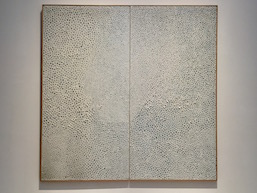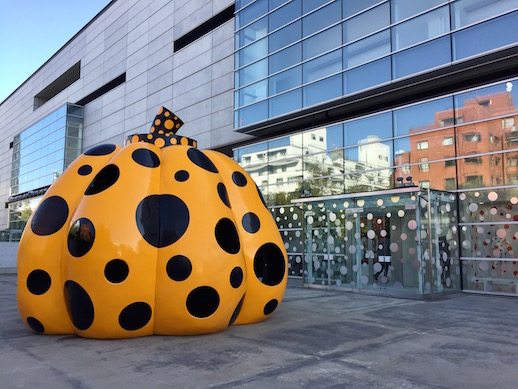The Eternal Soul of Yayoi Kusama

Walking into the enormous cavern of Yayoi Kusama at her National Art Center, Tokyo retrospective “My Eternal Soul,” you are greeted with a sensory overload. Her latest works are stacked floor to ceiling with identical-sized panels that engulf you in their bright radiance coupled with dark iconography. The sheer volume of work is enough to overwhelm you as you’re drawn into Kusama’s introspective mind and obsessive symbology. She started her latest series ‘My Eternal Soul’ (featured in the front room) in 2009 and the amount of exploration is truly remarkable for an artist at this late stage in a career that launched with commercial success in 1950s New York.
The personal symbology Kusama shares with you resembles organisms, botany and Aboriginal dreamtime paintings. Within the borders of the panels there is a personal story in which she simultaneously explores life, love and death. Like Aboriginal artists, she shares her stories and creates mind webs of psychological landscapes either through paint, sculpture or installation.

These plots contain striking primary colors juxtaposed with melting muted tones and repetitive motifs. Kusama invites you into the paintings but also creates environments for the viewer to wander through. In works such as Narcissus Garden (1966), a Greek hunter obsessed with his own image is playfully presented as a Narcissus garden of mirror orbs, exemplifying the artist’s exploration of love and death. The mortality of the artist is presented as an infinity, a formal element Kusama has examined in her work throughout her career, from her early New York-era ‘Infinity Nets’ (1958), a series of monochrome paintings in which loving attention is paid to each stroke of paint, to her Infinity Mirrored Room (2011) installation that beckons the observer into an endless void of colorful light orbs.
A disappointment of this show is the distraction of trying to see Kusama’s new work amid a kingdom of selfie snappers, the sounds of photo clicks diverting the serene power of Kusama’s enormous painting installation. Museum exhibitions rarely let you photograph the works and for good reason. This exception feels like a double standard. Luckily, the rest of her retrospective bans such an act.
“My Eternal Soul” carries you through paths of key works and a display of the artist’s development from her late 1930s work to present. Her involvement in the socio-political climate of America in the 1960–1970s establishes her as a Japanese artist concerned with international matters. Kusama also displays a concern with not letting culture or race interfere with the accessibility of her art. Her exploration of a range of mediums, from her 2012 collaboration with Louis Vuitton to her furniture collaboration with Graf d-3 in 2010, confirms the global scope of her ambitions. Kusama’s practice is thoroughly surveyed in this focused and accessible exploration that invites onlookers to engulf themselves in her colorful, sometimes dark world.

Simon DeBoer
Simon DeBoer



